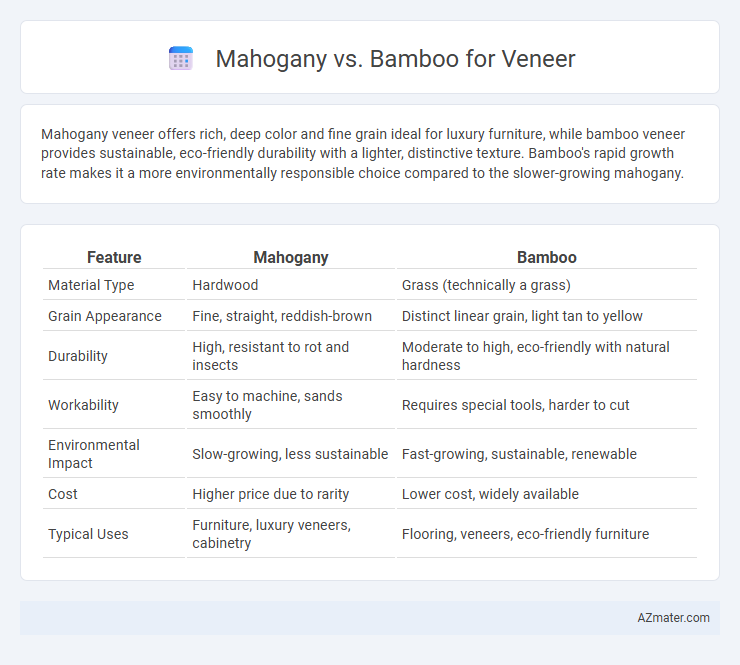Mahogany veneer offers rich, deep color and fine grain ideal for luxury furniture, while bamboo veneer provides sustainable, eco-friendly durability with a lighter, distinctive texture. Bamboo's rapid growth rate makes it a more environmentally responsible choice compared to the slower-growing mahogany.
Table of Comparison
| Feature | Mahogany | Bamboo |
|---|---|---|
| Material Type | Hardwood | Grass (technically a grass) |
| Grain Appearance | Fine, straight, reddish-brown | Distinct linear grain, light tan to yellow |
| Durability | High, resistant to rot and insects | Moderate to high, eco-friendly with natural hardness |
| Workability | Easy to machine, sands smoothly | Requires special tools, harder to cut |
| Environmental Impact | Slow-growing, less sustainable | Fast-growing, sustainable, renewable |
| Cost | Higher price due to rarity | Lower cost, widely available |
| Typical Uses | Furniture, luxury veneers, cabinetry | Flooring, veneers, eco-friendly furniture |
Introduction to Mahogany and Bamboo Veneer
Mahogany veneer is prized for its rich, reddish-brown hue, fine grain, and durability, making it a popular choice in high-end furniture and cabinetry. Bamboo veneer offers a sustainable alternative characterized by its light color, linear grain, and rapid renewability, often used in eco-friendly design projects. Both veneers provide versatile options for surface finishing, with mahogany delivering classic elegance and bamboo emphasizing environmental responsibility.
Botanical Origins and Growth Patterns
Mahogany, derived from trees in the Swietenia genus native to Central and South America, grows slowly in tropical rainforests, resulting in dense, fine-grained wood ideal for veneers. Bamboo, a fast-growing grass belonging to the Poaceae family, thrives in diverse climates across Asia and emits high tensile strength, making it a sustainable veneer alternative. The distinct botanical origins and growth patterns influence the texture, durability, and environmental impact of mahogany and bamboo veneers.
Physical Appearance and Aesthetic Appeal
Mahogany veneer showcases a rich, deep reddish-brown color with a fine, straight grain that exudes classic elegance and warmth, making it ideal for traditional and luxurious interiors. Bamboo veneer offers a lighter, more contemporary aesthetic with its natural golden hue and distinctive linear grain pattern that enhances modern and eco-friendly designs. Both veneers provide unique textural qualities; mahogany imparts a smooth, polished finish while bamboo delivers a subtle, textured surface that highlights its sustainable origin.
Strength and Durability Comparison
Mahogany veneer is renowned for its exceptional strength and resistance to wear, making it ideal for high-traffic furniture and cabinetry. Bamboo veneer, while slightly less dense, offers remarkable durability due to its natural resilience and fast growth, providing an eco-friendly alternative. In strength comparisons, mahogany typically outperforms bamboo in hardness, but bamboo's tensile strength and moisture resistance contribute to long-lasting veneer applications.
Sustainability and Environmental Impact
Mahogany veneer, prized for its rich color and durability, poses significant sustainability concerns due to slow growth rates and overharvesting in tropical forests, leading to habitat loss and biodiversity decline. Bamboo veneer offers an eco-friendly alternative with rapid renewability, high carbon sequestration, and lower environmental impact from cultivation, as it regenerates without replanting and requires minimal pesticides. Choosing bamboo veneer supports sustainable forestry practices and reduces deforestation-related emissions compared to mahogany.
Cost and Availability Factors
Mahogany veneer typically commands a higher price due to its premium status and limited availability, resulting from slower growth rates and stricter harvesting regulations. Bamboo veneer is more cost-effective and widely accessible, benefiting from rapid renewability and sustainable farming practices. Choosing between mahogany and bamboo veneers often depends on budget constraints and the importance of environmental sustainability in material sourcing.
Workability and Installation Process
Mahogany veneer offers exceptional workability due to its fine, straight grain and uniform texture, allowing for smooth cutting, sanding, and shaping without splintering. Bamboo veneer, being harder and denser, requires sharp tools and careful handling to prevent chipping during cutting but provides strong durability once installed. Installation of mahogany veneer is generally more forgiving, while bamboo demands precise adhesive application and acclimation to avoid warping or delamination.
Common Applications in Interior Design
Mahogany veneer is prized for its rich, warm tones and fine grain, making it ideal for luxurious furniture, paneling, and cabinetry in traditional and high-end interior designs. Bamboo veneer offers a sustainable, lightweight alternative with a unique linear texture, commonly used in modern, minimalist spaces for wall coverings, flooring, and eco-friendly furniture. Both materials bring distinct aesthetic and functional benefits, catering to diverse interior design styles and sustainability preferences.
Maintenance and Longevity Considerations
Mahogany veneer offers superior durability and ages gracefully with minimal maintenance, requiring occasional polishing to retain its rich, deep color. Bamboo veneer, while eco-friendly and resistant to moisture and pests, demands more frequent cleaning to prevent surface wear and warranties shorter lifespan due to its softer nature. Both veneers benefit from avoiding direct sunlight and excessive humidity to maintain structural integrity and appearance over time.
Conclusion: Choosing the Right Veneer
Mahogany veneer offers rich color and durability, ideal for high-end furniture requiring classic elegance, while bamboo veneer provides eco-friendly sustainability with a modern aesthetic and superior resistance to moisture. Selecting the right veneer depends on project requirements: prioritize mahogany for luxury and timeless appeal, choose bamboo for environmental impact and contemporary design. Both veneers deliver unique benefits, making the choice a balance between style preferences and environmental considerations.

Infographic: Mahogany vs Bamboo for Veneer
 azmater.com
azmater.com